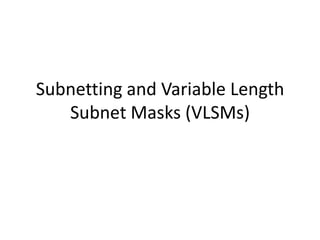
Subnetting class
- 1. Subnetting and Variable Length Subnet Masks (VLSMs)
- 2. Understanding Subnetting • Reduction of network traffic • Optimization of network performance • Easy management • Easy spanning in large geographical distances
- 3. Understanding Subnetting Class Format Default Subnet Mask A network.node.node.node 255.0.0.0 B network.network.node.node 255.255.0.0 C network.network.network.node 255.255.255.0 IP Address : 32 Bits From 00000000.00000000.00000000.00000000 To 11111111.11111111.11111111.11111111 In Hexadecimal: From 00.00.00.00 To FF.FF.FF.FF (broadcasting)
- 4. Understanding Subnetting Class Network Host Number of Addresses per Start End Bits Bits Networks Network Address Address A 8 24 128 (27) 16,777,216 (224) 0.0.0.0 127.255. 255.255 B 16 16 16,384 (214) 65,536 (216) 128.0.0.0 191.255. 255.255 C 24 8 2,097,152 (221) 256 (28) 192.0.0.0 223.255. 255.255
- 5. Easy way to subnet A. Remember the Classless Inter-Domain Routing table values, or B. Apply the following system: 1. Observe the Example 192.168.1.23/26 (CIDR) 1. 255 is 8 bits 2. 255.255 is 16 bits 3. 255.255.255 is 24 bits 4. Then 255.255.255.? 5. We need 2 more bits !
- 6. Easy way to subnet We need 2 bits to make /26 Octets Bit Needed 128 192 224 240 248 252 254 255 Subnet mask is 255.255.255.192
- 7. So, how many networks then? 128 64 32 16 8 4 2 1 Since 192.168.1.23 is a Class C network, we can only have 256 addresses If we want to have 64 subnets, we need to use increments of 64 or:
- 8. So, how many networks then? Subnet First Host Last Host Broadcasting 192.168.1.0 192.168.1.1 192.168.1.62 192.68.1.63 192.168.1.64 192.168.1.65 192.168.1.126 192.168.1.127 192.168.1.128 192.168.1.129 192.168.1.190 192.168.1.191 192.168.1.192 192.168.1.193 192.168.1.254 192.168.1.255
- 9. Variable Length Subnet Mask VLSM • VLSM designs use different subnet mask. Example: – Subnet 1: 192.168.10.64/29 (6 hosts) – Subnet 2: 192.168.10.48/28 (10 hosts) – Subnet 3: 192.168.10.72/30 (2 hosts) • Makes the usage of IP addresses even more efficient than standard Subnetting.
- 10. Variable Length Subnet Mask VLSM Block sizes CIDR MASK HOSTS Block Size /25 128 126 128 /26 192 62 64 /27 224 30 32 /28 240 14 16 /29 248 6 8 /30 252 2 4
- 11. VLSM Design
